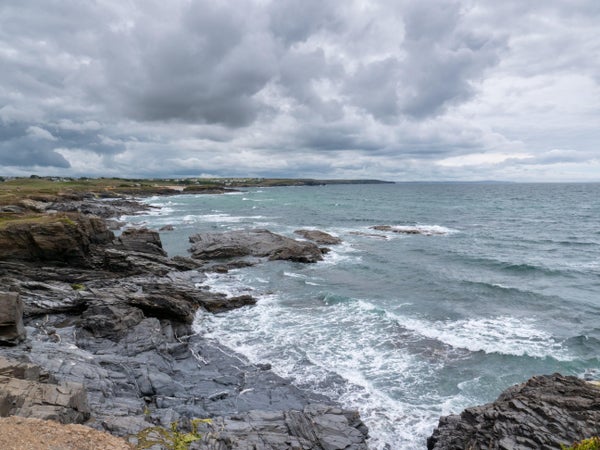A gigantic ocean current, which transports heat around the globe and helps regulate weather patterns throughout the North Atlantic, appears to be slowing down. In fact, recent research has found that it’s currently at its weakest point in the last 1,000 years.
The big question: Is climate change causing the slowdown? Or is it just a natural fluctuation?
For now, scientists say, it’s probably some of both.
On supporting science journalism
If you're enjoying this article, consider supporting our award-winning journalism by subscribing. By purchasing a subscription you are helping to ensure the future of impactful stories about the discoveries and ideas shaping our world today.
A new study, published Monday in the journal Nature Climate Change, finds that the current is indeed slowing and that climate change is likely playing at least a small part. But the current’s behavior is still within the range of its own natural patterns.
In other words, the climate change signal hasn’t yet pushed the current outside the bounds of its historically “normal” behavior. The signal from natural variability “basically dominates” the signal from human-caused warming, according to lead study author Mojib Latif, a scientist at the GEOMAR Helmholtz Centre for Ocean Research Kiel in Germany.
Still, that’s likely to change at some point in the future. Climate models indicate that human-caused global warming should cause the current to continue slowing over time. If the world keeps on warming, the current’s behavior eventually should tip outside the bounds of natural variability, flowing into uncharted territory.
Exactly how quickly that process will unfold, and how strong the slowing will be, is still a matter of scientific debate. But it’s a serious question.
Officially known as the Atlantic Meridional Overturning Circulation, or AMOC, the current ferries heat between the equator and the Arctic like a giant liquid conveyor belt. As a result, it’s largely responsible for the mild weather conditions enjoyed by much of the North Atlantic region, including Europe and the eastern United States.
If the current continues to slow, it could disrupt weather patterns throughout the midlatitudes. Parts of the North Atlantic may cool, while areas farther south along the U.S. East Coast may get warmer.
In fact, some data suggests these processes already are starting to happen.
Multiple studies in recent years have made it clear the AMOC is slowing. Some research suggests it may have been weakening for at least 150 years.
Still, the best, most direct measurements of the AMOC’s flow come from the last 20 years or so, when scientists began installing wide networks of special ocean sensors throughout the region. That makes it challenging to compare the AMOC today with its past behavior—meaning it’s difficult to determine whether the current slowdowns are part of a natural pattern.
Scientists have found various ways to address the issue. Some studies have used long-buried sediment samples pulled from the ocean floor. These samples contain chemical information about what ocean conditions were like hundreds of years ago.
The new study uses historical records of sea surface temperatures throughout the Atlantic, dating back to the year 1900. Because changes in the AMOC’s flow can affect ocean temperatures in different ways throughout the region, these records can help scientists evaluate how the current has changed over time.
They also paired their historical analyses with simulations from climate models, which help them investigate the causes behind changes in the AMOC.
The study suggests there is, in fact, a signal from human-caused global warming. Climate change is playing at least some role in the AMOC’s behavior.
It’s “a kind of fingerprint” of human-caused warming, according to Latif.
But the influence of natural variability is, for now, still stronger. The AMOC has a tendency to fluctuate over time, and its current behavior is still within the bounds of a natural pattern.
This doesn’t mean the current isn’t slowing or that global warming isn’t playing a part, Latif cautioned. The current is, indeed, slowing down. And even if it’s still within the bounds of natural behavior, the influence of climate change is getting stronger all the time in the background.
“As greenhouse gases continue to accumulate in the atmosphere, all models predict a major slowing of the circulation,” he said. It’s just a matter of when that signal becomes the dominant force acting on the current. If not today, then it will be at some point in the future as long as the planet continues to warm.
The study’s findings are “fully consistent” with other recent research on the AMOC’s slowing, said Stefan Rahmstorf, an ocean expert at the Potsdam Institute for Climate Impact Research in Germany, in an email to E&E News. Rahmstorf wasn’t involved with the new study, but has published several major papers over the last few years on the weakening AMOC.
He noted there’s ample evidence for at least some influence from human-caused warming. That includes the “fingerprint” of climate change observed in the new paper this week, the fact that climate models predict a slowdown in response to greenhouse gas emissions and the trend in which recent slowing appears to be the most extreme in the last millennium.
The study also highlights the importance of continued direct monitoring in the Atlantic, Latif added. Ocean sensors aren’t cheap to install or maintain, and they need continuous funding. But they’re the best way for scientists to keep tabs on what’s really happening to the AMOC over time.
“All this needs to be maintained,” Latif said. “That’s the bottom line.”
Reprinted from E&E News with permission from POLITICO, LLC. Copyright 2022. E&E News provides essential news for energy and environment professionals.
